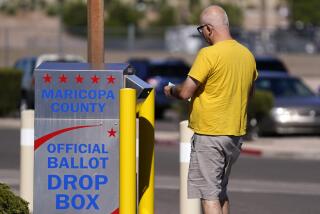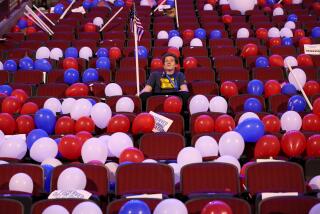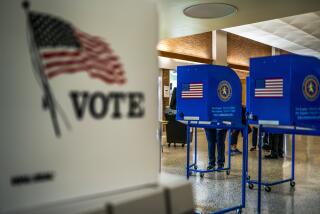GOP Leaders Fear That Frantic Pace of Primaries Leaves Voters Out in Cold
- Share via
MIAMI — Just one look.
That may not be all it takes to pick a presidential nominee, but Republican voters have been lucky to get even that much of a glance at the GOP candidates as they hurtle along the absurdly accelerated primary calendar this year. With 22 states holding primaries in the first three weeks of March alone, the candidates have rushed through the country like airline passengers late for a connection.
Florida, the nation’s fourth-largest state in population, is a pivotal contest in the fall and a cornerstone of the emerging Republican majority in the South. But the candidates have left less of an imprint here than the wind on the sand. In the week before Tuesday’s primary, Patrick J. Buchanan managed to squeeze out one day for the state, and Sen. Bob Dole came in for two and thin slivers of two others.
Neither New York (which voted Thursday) nor Texas (which comes Tuesday) fared much better. New York used to be the Pepto primary: As columnist Jeff Greenfield recently observed, once it tested the candidates’ ability to pronounce, let alone digest, a global delicatessen of ethnic foods as they poked through the state’s diverse nooks and crannies.
No more. With its vote squeezed in late last week between the eight primaries on “Junior Tuesday” and the seven more this week on “Super Tuesday,” Dole and Buchanan didn’t spend enough time in New York to order a shrink-wrapped ham-and-cheese sandwich at the airport, much less a knish in Brighton Beach.
It’s no commentary on the apparent result of this year’s contest, the all but certain nomination of Dole, that a growing number of Republican leaders are complaining that the compression of the primary calendar (“front-loading,” as the politicos call it) has gone too far.
“We have a terrible method of selecting a presidential nominee,” said Florida GOP Chairman Tom Slade. “There is no question it needs very substantial modification.”
“We get lost in the process,” complained Texas GOP Chairman Tom Pauken.
“I don’t like what I see happening,” worried California GOP Chairman John Herrington. “This compressed schedule . . . is a feeding frenzy [with] the amount of importance that has been put on ads, television, money.”
Not everyone is so concerned. Massachusetts GOP Chairman Jim Rappoport says the process has worked as intended by producing an early resolution to the race: “It has been a huge success.”
But Ron Kaufman, the former political director for George Bush, notes that this early conclusion has been purchased at a heavy price: a frantic pace to the balloting that has left many Republicans feeling “disenfranchised.” Alienation over being asked to choose before they could coherently examine the candidates may partly explain why so many Republicans tell pollsters they wish another candidate were in the race, Kaufman believes.
Even Republican National Committee Chairman Haley Barbour is plainly concerned that the process may be shortchanging voters. Earlier this year, Barbour appointed a party committee to study the speed-up of the primary calendar--an unusual step for Republicans, who usually take a states-rights, hands-off approach to the nomination process.
“I appointed this task force because of my concern that the primaries were pressed so close together . . . that a voter would have very little time to reflect, or to consider what would happen if his or her favorite candidate dropped out early,” Barbour said. “It just all goes so fast that it raises the question of: Is this in the interest of picking the strongest nominee, and voters having their real opportunity to look over the field?”
How did the race for the nomination mutate from a marathon to a sprint? Both parties, and several distinct considerations, have contributed to the speed-up that began in earnest in 1988 and accelerated in the two campaigns since then.
Some states have moved their primaries forward to benefit specific candidates, or types of candidates. Southern Democrats created the early March Super Tuesday showdown in 1988 with the goal of tilting the field toward a more conservative nominee (it didn’t work); Texas agreed to join that year’s Super Tuesday partly to help adopted favorite son George Bush win the GOP nomination (that did work). In 1992, Georgia leapfrogged from Super Tuesday to Junior Tuesday, one week earlier, to boost Bill Clinton, a close ally of Georgia Gov. Zell Miller.
More important than these tactical maneuvers have been two larger calculations. One is the desire by national party leaders to suppress insurgencies and increase the odds that the parties will nominate well-respected, well-financed veterans such as Dole. The second has been the desire of some states to diminish the influence of the first states on the calendar by elbowing into line just behind them.
The first of these assumptions has proved correct, but shortsighted. The second--that states would increase their influence by moving forward--has proved flatly wrong. “It’s the law of unintended consequences,” Barbour said.
With so many contests following so soon after Iowa, New Hampshire and South Carolina--the troika at the front of the GOP field that still receives personalized attention--the states crammed into early March have melted into an undifferentiated mass that leaves each of them with less say in the selection.
Because of their underlying demographic and ideological trends, different states may still prefer different candidates. But candidates have almost no time to tease out those distinctions with campaigns that let voters make an independent judgment. The principal piece of information voters in Colorado or Texas or Florida receive about the candidates is who won the states that voted just before. As a result, the reverberations from the first contests drive the states packed into the first half of March. Momentum overwhelms message, and even mega-states are reduced to little more than dominoes.
This compression has helped the best-financed, best-known candidates, who enjoy national name recognition and have the most money to compete simultaneously from coast to coast. But this acceleration ultimately hurts even the front-runners.
Candidates benefited in two distinct respects from a more leisurely process that allowed them to spend a week or more in states such as New York, Texas or California, when those behemoths voted later in the spring. The primaries offer presidential candidates their last chance to explore and learn something about a state and its people before they are permanently entombed in the cocoon of the general election campaign. The reverse is also true: Historically, the primaries have allowed the candidates to introduce themselves to states they must inevitably hurry through during the general election.
That’s a loss particularly for Dole, whose taciturn and stoic style doesn’t usually make as strong a first impression as President Clinton’s loquacious empathy. Dole’s many virtues--integrity, decency, solidity--reveal themselves only through prolonged exposure. Yet in most places, Dole has been nothing more than a blue-suited blur.
And now, because the calendar has been so compressed, Dole will soon hit the legal spending limit for the primaries. That will make it difficult for him to broadcast his message until he receives his general election funding in August.
Can anything be done to reverse this rush to judgment? Barbour’s task force is due to report in June, but it would be a wrenching change for the RNC, with its laissez-faire tradition, to take it upon itself to rewrite the rules for scheduling primaries. In Texas, Pauken is pushing to move the primary back to its former date in May, but few states may be attracted to such unilateral disarmament.
Since the problem has been bipartisan and nationwide, the better solution is for the two parties to jointly act on a national basis. Barbour has already approached Democratic National Committee Chairman Christopher J. Dodd to discuss the issue.
The best idea kicking around in political circles is to return to the more staggered process that allowed an ebb and flow in the race. In one idea under discussion, the parties would let states hold their primaries only on about half a dozen designated days spaced two or three weeks apart from March through June. Iowa and New Hampshire would still go first, but, just as distance deadens the roar of an explosion, their impact would be muffled if no other states voted for three weeks after them, and no more than eight states could vote on any of the designated primary days.
Other answers may emerge if the will to change is there. The critical first step is to acknowledge that in stampeding to the front of the line, the states have trampled over the interest of their voters.
The Washington Outlook column appears here every other Monday.
More to Read
Get the L.A. Times Politics newsletter
Deeply reported insights into legislation, politics and policy from Sacramento, Washington and beyond. In your inbox three times per week.
You may occasionally receive promotional content from the Los Angeles Times.










